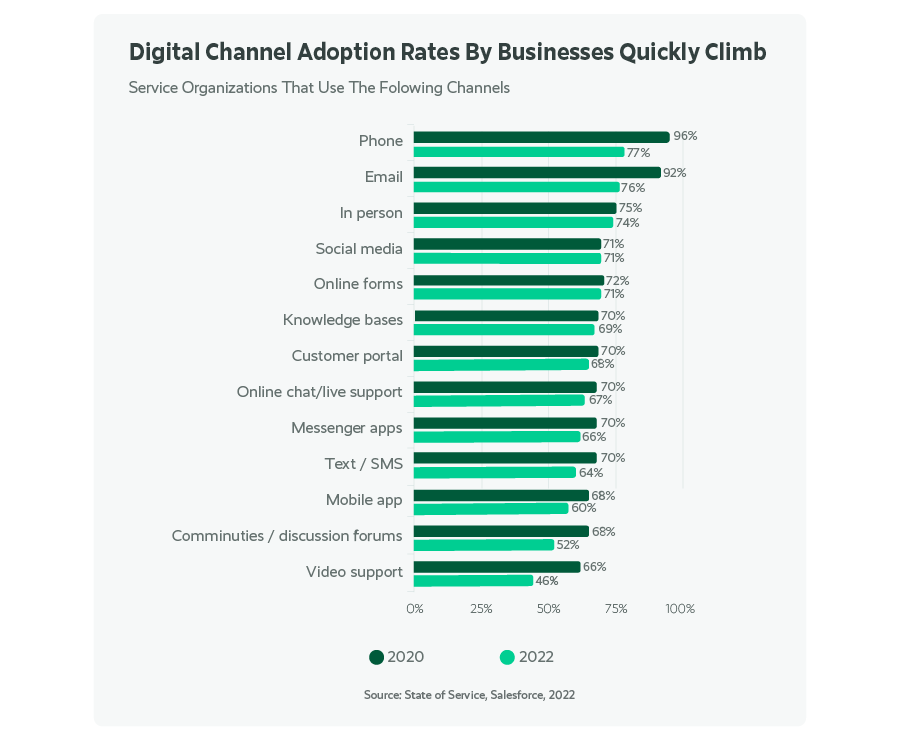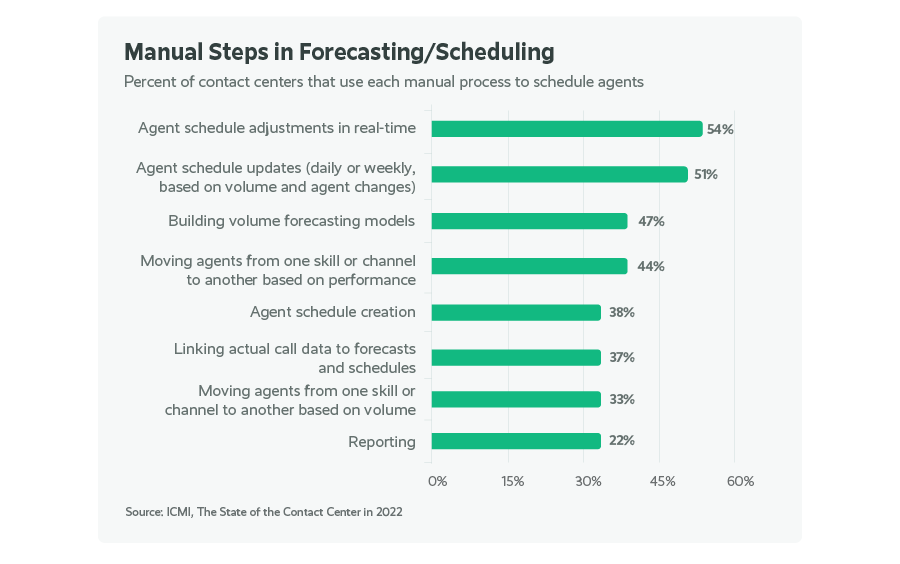The Importance of Accurate Forecasting for Omnichannel Volume
Contact centers have changed drastically in recent years. The once “in-person” centers dealing with inbound calls have been replaced by global, distributed customer experience teams.
In addition, new online channels have emerged to help companies serve customers in an increasingly digital landscape. New ways to improve customer retention and loyalty, as well as increase the customer base and boost customer satisfaction levels, are always popping up.
Customer service centers will continue to entrench themselves in innovation, adapting to customers’ ever-increasing needs and demands while safeguarding employee experience.
As a result, organizations have adopted agile, efficient, and scalable cloud-based tools. This is evident in the growth of CCaaS, a market hurtling toward a projected $19.8 billion valuation by 2031.
In this post, we’ll explore several trends that are driving this growth and are influencing contact center leaders’ decision-making.

Engagement Is Now Digital First
Since 2020, online digital interactions between companies and customers have accelerated. Fifty-seven percent (57%) of customers from all generations now prefer to engage companies through digital channels.
For customers who prefer immediate resolution, live chat has become a channel of choice. It allows a customer to contact the business based on a time that’s suitable for them and remain productive in their daily lives. For less urgent inquiries, customers lean on email as a preferred communication channel.

Related Article: Why A Digital Contact Center Is Essential for Meeting Today’s Customer Expectations
Digital Channels Aren’t All The Same
As digital channel uptake accelerates, why is it important for contact center operations to understand the difference in terms of workforce planning?
Each digital channel is unique and is not one-size-fits-all when it comes to planning. Some channels are considered asynchronous, which refers to communication between an agent and a customer that does not happen at the same time. Common examples are emails or texts where the customer is not expecting a real-time response.
Synchronous channels refer to channels in which interactions are live and both parties are communicating at the same time. Live chat or phone calls are good examples. As you can imagine, there are significant differences in how you plan and staff for these channels.
What Is Digital Transformation?
Digital transformation is a buzzword that has been floating around for the last few years. But what does it really mean? Simply put, digital transformation is the process of integrating technology into your organization to create or modify business processes to meet changing requirements and enhance customer experience.
Digital transformation is more than just purchasing technology. It’s about adapting your business’s processes, and it’s a complete change in how your business engages with your customers. That said, it doesn’t need to be complicated, but it does need to be efficient and effective in solving pain points that you have in your business.
Digital channels have become an integral part of the way that organizations connect with their customers — whether that’s email, social media, live chat, SMS, or good old-fashioned telephone calls.
Developing your customer support center to support digital channels is an essential first step in the journey to redefining the call center’s role in customer service. Once you achieve this, you need to consider your workforce planning with digital and omnichannel forecasting for customer service in mind.
Related Article: Why A Digital Contact Center Is Essential for Meeting Today’s Customer Expectations
Why Do Contact Centers Need To Forecast?
We often hear the term “forecast” in relation to the weather. Forecasting for workforce planning is much the same thing. Just as data is used to determine future weather conditions, workforce planning forecasting uses historical data to make informed estimates about the direction of future trends, seasonality, and staffing requirements.
Workforce management (WFM) is a process that maximizes performance levels and competency for an organization. WFM involves effectively forecasting labor requirements and creating and managing staff schedules to accomplish a particular task on a day-to-day and hour-to-hour basis.
WFM systems enable organizations to gain insights into such business metrics as the exact number of employees needed to complete a particular job at a given time of the day, week, or month. It also helps track employees’ daily performance.
For example, in a contact center, WFM helps maximize the use of agent labor by forecasting the volume of interactions — calls, emails, chat, ticketing, etc. — and scheduling the correct number of agents with the right skills at the right time to handle the expected volume of transactions.
According to 2022 research by ICMI, almost half of contact centers (47%) are still manually creating forecasting models. An AI-driven workforce management solution does the heavy lifting to automate forecasting and many of the other repetitive and time-consuming manual tasks in contact center workforce management. This lets workforce managers focus instead on the analysis of data and insights to feed the continuous improvement cycle.

Let’s also consider the need to provide agile agent schedules to boost agent engagement and performance. Many WFM tools now consider actual agent availability to assist with scheduling. But contact centers shouldn’t just make decisions on the fly. Ideally, every staffing decision they make and every budget they allocate should be based on informed insight through accurate forecasting.
Automated forecasting from workforce management software gives contact centers the best chance of being right. When looking to stay one step ahead of the competition, this could make all the difference. Forecasting is critical because the other option is pure guesswork.
No contact center wants to be caught off-guard by unexpected volumes and missed service levels on a daily basis or be blind to what is going on in real time across their business. This all harms customer retention, resolution times, and customer satisfaction ratings.
Forecasting helps contact centers plan for both the short and long term. It can also help you identify the best areas to spend — whether it’s investment in additional resources, investment in training and development of your people, improving customer retention, or improving service channels. Every contact center has areas where their money is best spent — the trick is to know where these areas are.
Forecasting is all about optimizing your costly resources. If your forecasting solution is inaccurately calculating the staffing you need, the result could be being overstaffed, which is very costly to an organization. People sitting around and not being productive is bad for morale and customer experience.
Inaccurate forecasts can also result in being understaffed, which is also very costly because it can create agent burnout and turnover, not to mention countless bad experiences because you don’t have enough people to serve the volume of interactions.
Related Article: The Role of Real-Time Data in Workforce Management
What Is Contact Center Omnichannel Forecasting?
An omnichannel contact center is a customer experience strategy for delivering a seamless experience across multiple channels and social interactions.
As call centers have evolved into contact centers, they are no longer dealing with voice interactions alone. They serve multiple channels of communication so that customers can contact them via their channel of choice.
Workforce management has therefore had to evolve to be able to forecast and schedule accurately across many distinct channels. This requires multiple calculations to ensure that each channel is forecasted accurately and that you have the right people with the right skills.
Spreadsheets aren’t robust enough to handle these complex factors. No matter how sophisticated it might be, a spreadsheet can’t keep up with the challenges of omnichannel forecasting.
Related Article: Can Your WFM Solution Accurately Forecast In A Modern Digital Contact Center?
Examples Of Contact Center Omnichannel Forecasting Challenges
Omnichannel forecasting requires a balancing act of many factors that weren’t an issue in the days of voice-only call centers.
Voice was relatively easy to forecast as it is a synchronous activity. In synchronous communications, multiple parties continually listen for and act upon replies from each other and agents can only deal with one voice call at a time.
When we look at asynchronous activity such as email interactions, the customer does not expect to receive a response in real time. Sure, there will be a service-level agreement (SLA) associated with how quickly the contact center responds, but it is very different from a voice interaction.
Asynchronous communications typically incur a delay between when the sender initiates the message and when the recipient responds. When we add in the extra complexity of agents being able to service more than one of these interactions at the same time (concurrency), this is where workforce planning and employee scheduling get tricky.
These two forms of communication can be easy to understand in terms of human communications, but it’s significantly more difficult to plan for in terms of workforce management.
In our “always on” world, call centers have introduced new communication channels for many reasons, including lowering labor costs and increased customer expectations. So embracing the digital age is inevitable. The way we approach workforce management must follow suit. Not only to ensure accurate forecasting and scheduling in a digital environment but to ensure a seamless experience for your customers, regardless of channel.
Related Article: How to Deliver An Outstanding Omnichannel Customer Experience
Effective Workforce Management For Today’s Digital-First Contact Centers
As digital channels continue to grow in options for consumers, the volumes associated with them are ever-increasing. This brings new challenges for workforce managers and planners and increases the workload for contact center managers. Add to this the growing demands of the younger demographics in the workplace for flexible work and the case grows even stronger.
Traditionally, WFM software solutions have been both designed and built with only voice in mind. Forecasting for offline channels like voice is straightforward: the call comes in, there is an expectation to answer it in a timely fashion, the agent answers the call, and details such as handle time and wrap-up time are captured.
But in today’s digital world, it’s more complicated. Agents can be expected to handle immediate response interactions such as phone and chat, as well as deferred response interactions such as tickets, social media, and e-mail. The responses to the latter type of interaction are often spread over a period of time. Agents are also more likely to “work” more than one of these interactions at the same time.
This concurrency also needs to be considered as part of contact center omnichannel forecasting. From the customer side, these types of interactions are often characterized by gaps in response time. Add multi-skilling into the mix and it becomes a major operational headache. All of this has significant implications for agent staffing and planning.
Related Article: Make Every Agent Your Best Agent With WFM — Even Remotely
Multi-Workload Workstreams and Forecasts
Let’s think about the customer journey in today’s digital-first environment. A workstream represents an end-to-end inquiry from a customer. During the lifecycle of this inquiry, multiple agents may be involved in the resolution. For example, the interaction is initiated by an inbound voice call, a ticket is then created, and the ticket is “touched” three times by three different agents before it’s considered resolved.
The tracking of workloads at this interaction level allows different workloads to be associated with each agent interaction. This, in turn, enables workforce schedulers and planners to understand the different categories of work required to resolve a single customer inquiry, not just the voice part of the interaction.
It is also important to understand the number of teams involved in handling an inquiry. This is where multi-workload workstreams come into play, as they enable contact centers to record the work efforts associated with each workload within the workstream. For example, customer service is the workstream, but it has three workloads associated with it:
- 1. Complaints
- 2. Billing
- 3. Support
This breakdown of handle times is key to being able to create a multi-workload forecast.
How Does This Impact Omnichannel Forecasting?
Forecast volumes are based on historical data. This remains true with omnichannel forecasting. However, when it comes to determining employee staffing requirements, this volume will be combined with the handle time profiles across all workloads associated with the workstream.
New KPI Metrics And Algorithms
Along with the new era of digital comes a new set of key performance indicators (KPIs) and algorithms that become crucial for accurate omnichannel forecasting and scheduling of agents. Erlang C is no longer sufficient for omnichannel interactions. Here are examples of just a few of the new-era digital planning KPIs;
- Average First Answer Handle Time (AFAHT)
- Average First Solved Handle Time (AFSHT)
- Average Total Handle Time (ATHT)
- First Answer Time (FAT)
- First Interaction Percentage
- First Solve
- Total Reopens
- Total Replies
- Total Touch Time
- Total Touches
The list goes on. You cannot continue to use old metrics in the new era of digital. The transactions are different, how we interact and service these transactions is different, how we calculate the time associated with these transactions is different, their SLAs are different, and customer expectations are different.
Related Article: Why We Use AI in Playvox WFM (and How It Improves Contact Center Metrics)
Embrace The Digital Contact Center
Digital channels offer a wealth of opportunities for contact centers to better meet the ever-growing needs and demands of their customers. Not only do they offer choice, but they are often a much lower cost to serve. However, omnichannel volume does introduce new complexity for workforce planning and management.
By understanding how workforce planning will continue to be affected by the unique characteristics of digital channels — from synchronous and asynchronous interactions to deferred work, concurrent activity, and more — you will be positioned to meet the needs of your customers in the digital era.
To learn how Playvox can help make contact center omnichannel forecasting more efficient for your organization, request a demo.







